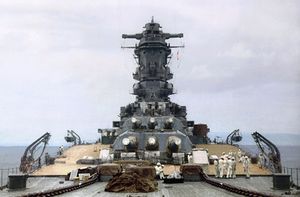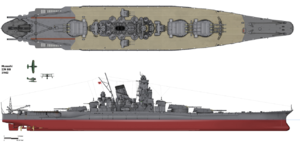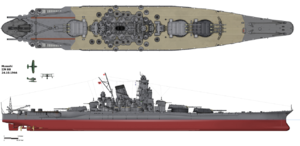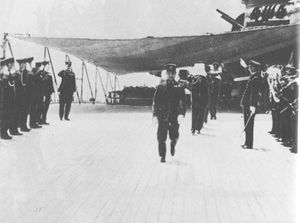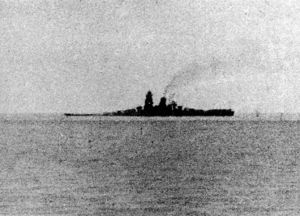موساشي، البارجة اليابانية
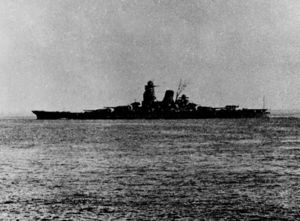 Musashi leaving Brunei in October 1944 for the Battle of Leyte Gulf
| |
| التاريخ | |
|---|---|
| الاسم: | Musashi |
| السمِيْ: | Province of Musashi |
| طُلِبت: | June 1937 |
| الباني: | Mitsubishi Shipyard, Nagasaki |
| وُضِع هيكلها: | 29 March 1938 |
| أُطلِقت: | 1 November 1940 |
| بدأت الخدمة: | 5 August 1942 |
| ضُربت: | 31 August 1945 |
| المصير: | Sunk during the Battle of Leyte Gulf, 24 October 1944 |
| السمات العامة (as built) | |
| الفئة والنوع: | Yamato، طراز battleship |
| الازاحة: | |
| الطول: | |
| العارضة: | 36.9 m (121 ft 1 in) |
| الغاطس: | 10.86 m (35 ft 8 in) (full load) |
| قدرة التركيب: |
|
| الدفع: |
|
| السرعة: | 27.46 knots (50.86 km/h; 31.60 mph) |
| المدى: | 7,200 nmi (13,300 km; 8,300 mi) at 16 knots (30 km/h; 18 mph) |
| المرافقون: | 2,500 |
| المجسات وأنظمة المعالجة: |
|
| التسليح: |
|
| الدروع: |
|
| الطائرات المحمولة: | 6–7 × Nakajima E8N or Nakajima E4N floatplanes |
| إمكانيات الطيران: | 2 × catapults |
Musashi (武蔵), named after an ancient Japanese province,[1] was one of two Yamato، طراز battleships[N 1] built for the Imperial Japanese Navy (IJN), beginning in the late 1930s. The Yamato-class ships were the heaviest and most powerfully armed battleships ever constructed,[3] displacing almost 72,000 long tons (73,000 t) fully loaded and armed with nine 46-centimetre (18.1 in) main guns. Their secondary armament consisted of four 15.5-centimetre (6.1 in) triple-gun turrets formerly used by the Mogami، طراز cruisers. They were equipped with six or seven floatplanes to conduct reconnaissance.
Commissioned in mid-1942, Musashi was modified to serve as the flagship of the Combined Fleet, and spent the rest of the year working up. The ship was transferred to Truk in early 1943 and sortied several times that year with the fleet in unsuccessful searches for American forces. She was used to transfer forces and equipment between Japan and various occupied islands several times in 1944. Torpedoed in early 1944 by an American submarine, Musashi was forced to return to Japan for repairs, where the navy greatly augmented her anti-aircraft armament. She was present during the Battle of the Philippine Sea in June, but did not come in contact with American surface forces. Musashi was sunk by an estimated 19 torpedo and 17 bomb hits from American carrier-based aircraft on 24 October 1944 during the Battle of Leyte Gulf. Over half of her crew was rescued. Her wreck was located in March 2015 by Microsoft co-founder Paul Allen and his team of researchers.
. . . . . . . . . . . . . . . . . . . . . . . . . . . . . . . . . . . . . . . . . . . . . . . . . . . . . . . . . . . . . . . . . . . . . . . . . . . . . . . . . . . . . . . . . . . . . . . . . . . . . . . . . . . . . . . . . . . . . . . . . . . . . . . . . . . . . . . . . . . . . . . . . . . . . . . . . . . . . . . . . . . . . . . .
التصميم والوصف
التسليح
التدريع
الطائرات
الإنشاء
To cope with Musashi's great size and weight, the construction slipway was reinforced, nearby workshops were expanded, and two floating cranes were built. The ship's keel was laid down on 29 March 1938 at Mitsubishi's Nagasaki shipyard, and was designated "Battleship No. 2". Throughout construction, a large curtain made of hemp rope weighing 408 t (450 short tons) prevented outsiders from viewing construction.[4][5][N 2]
الخدمة
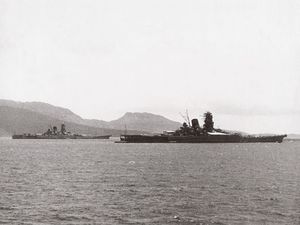

معركة خليج ليتي
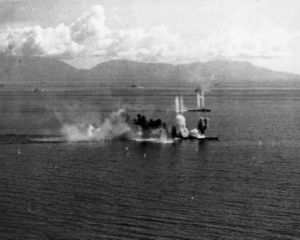
الاكتشاف
ملاحظات
- ^ Four ships were begun, but only two were completed as battleships. The third, Shinano, was completed as an aircraft carrier and the fourth was scrapped before completion.[2]
- ^ The amount of sisal rope necessary to complete the curtain was so great that it caused a shortage in the fishing industry.[6]
الهامش
المصادر
- Bawal, Raymond A. (2010). Titans of the Rising Sun: The Rise and Fall of Japan's Yamato Class Battleships. Inland Expressions. ISBN 0-9818157-3-1.
- Campbell, John (1985). Naval Weapons of World War II. Annapolis, Maryland: Naval Institute Press. ISBN 0-87021-459-4.
- Chesneau, Roger, ed. (1980). Conway's All the World's Fighting Ships 1922–1946. Greenwich, UK: Conway Maritime Press. ISBN 0-85177-146-7.
- Garzke, William H.; Dulin, Robert O. (1985). Battleships: Axis and Neutral Battleships in World War II. Annapolis, Maryland: Naval Institute Press. ISBN 978-0-87021-101-0.
- Hackett, Bob; Kingsepp, Sander (2012). "IJN Battleship Musashi: Tabular Record of Movement". Combinedfleet.com. Retrieved 17 April 2013.
- Holtzworth, E.C., Commander (January 1946). "Reports of the US Naval Technical Mission to Japan: Ship and Related Targets - Article 2: Yamato(BB), Musashi(BB), Taiho(CV), Shinano(CV)" (PDF). United States Navy. Retrieved 28 April 2013.
{{cite web}}: CS1 maint: multiple names: authors list (link) - Jentschura, Hansgeorg; Jung, Dieter; Mickel, Peter (1977). Warships of the Imperial Japanese Navy, 1869–1945. Annapolis, Maryland: United States Naval Institute. ISBN 0-87021-893-X.
- Lacroix, Eric; Wells, Linton (1997). Japanese Cruisers of the Pacific War. Annapolis, Maryland: Naval Institute Press. ISBN 0-87021-311-3.
- Padfield, Peter (2000). Battleship. Edinburgh: Birlinn. ISBN 1-84158-080-5.
- Polmar, Norman; Genda, Minoru (2006). Aircraft Carriers: A History of Carrier Aviation and Its Influence on World Events. Vol. Volume 1, 1909–1945. Washington, D.C.: Potomac Books. ISBN 1-57488-663-0.
{{cite book}}:|volume=has extra text (help) - Silverstone, Paul H. (1984). Directory of the World's Capital Ships. New York: Hippocrene Books. ISBN 0-88254-979-0.
- Skulski, Janusz (1995). The Battleship Yamato. Anatomy of the Ship (reprint of the 1988 ed.). London: Conway Maritime Press. ISBN 0-85177-490-3.
- Stille, Mark (2008). Imperial Japanese Navy Battleships 1941–45. New Vanguard. Vol. 146. Botley, Oxford, UK: Osprey Publishing. ISBN 1-84603-280-6.
- Whitley, M. J. (1999). Battleships of World War Two: An International Encyclopedia. Annapolis, Maryland: Naval Institute Press. ISBN 1-55750-184-X.
- Yoshimura, Akira (1999). Battleship Musashi: The Making and Sinking of the World's Greatest Battleship. Tokyo: Kodansha International. ISBN 4-7700-2400-2.
. . . . . . . . . . . . . . . . . . . . . . . . . . . . . . . . . . . . . . . . . . . . . . . . . . . . . . . . . . . . . . . . . . . . . . . . . . . . . . . . . . . . . . . . . . . . . . . . . . . . . . . . . . . . . . . . . . . . . . . . . . . . . . . . . . . . . . . . . . . . . . . . . . . . . . . . . . . . . . . . . . . . . . . .
